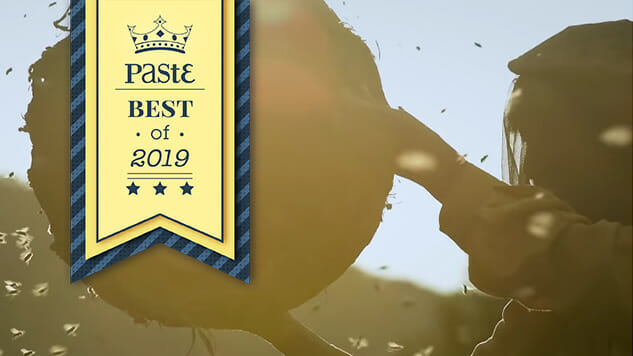
Most of the following documentaries are attempts at preservation: of memory, of ingenuity, of great artistry, of the planet. We all seem to be losing something, or just losing in general—so we struggle to keep things that once made us happy, or gave us hope, alive. We are usually only marginally successful.
Speaking of, we recently ranked our picks for the best documentaries of the past decade, some of which appear in the (unranked) list below. We are nothing if not rigorously consistent.
Here are the 15 best documentaries of 2019:
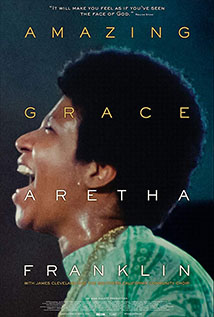 Amazing Grace
Amazing Grace
Director: N/A
A few years after the Apollo 11 mission, a different type of cosmic occurrence occurred at the New Temple Missionary Baptist Church in Los Angeles. Over two nights in January 1972, Aretha Franklin (just shy of her 30th birthday) recorded what would become the greatest-selling gospel album of all time—and arguably her finest album, period. The record Amazing Grace has been with us ever since, but the record of that night, shot by a young filmmaker named Sydney Pollack, has been kept away from public view for myriad reasons. Sadly, it took Franklin’s death last year at the age of 76 for that film to finally come to light. Though Amazing Grace was probably destined to be one of those much-rumored “lost” films that could never live up to its legend once the world got to see it, it’s a titanic vision of a performer whose extraordinary gift is self-evident, and the movie simply lets her be her magnificent self. Not credited to any director but completed by music producer Alan Elliott (and shot by Sydney Pollack), Amazing Grace is a straightforward presentation of archival materials without contemporary context or insights. But that’s enough, because history roars to life in this film, especially whenever Franklin opens her mouth and that incredible voice pours out. And, among its many attributes, Amazing Grace brings back the young Aretha Franklin who’s a human being rather than the totemic figure she became. She’s touchingly vulnerable, hesitant, normal in between songs, as if she’s just living her life, not consciously delivering an iconic album. And while the music critic in me will note that it’s a tad disappointing that the film peaks early, with her excellent version of Marvin Gaye’s “Wholy Holy” as the night’s first song, Amazing Grace hums with the thrill of lightning being captured in a bottle—a thrill that’s as much a treat for the eyes as the ears. —Tim Grierson
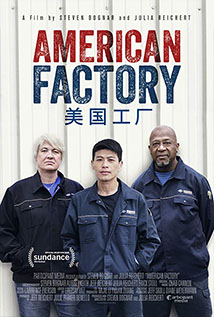 American Factory
American Factory
Directors: Steven Bognar, Julia Reichert
The plight of the American Rust Belt in the era of globalization, mechanized labor and outsourced jobs is real but, also, a media construct that’s been simplified into a talking point. For those not experiencing that reality on a daily basis, it can very easily become an abstraction. Steven Bognar and Julia Reichert’s American Factory sympathetically illustrates what those everyday pains look like, bringing us into the world of an Ohio automotive plant laid low by the 2008 recession. Several years after the factory closed, a Chinese company called Fuyao moved in, hiring back many of the employees of the old plant and offering hope to an economically depressed community. The American workers would help build windshields for cars and, ideally, along the way discover that Chinese and American employees can live together in harmony.
Bognar and Reichert’s film chronicles how that wishful thinking collapsed, but this is not a simpleminded story in which we can grasp onto an easy rooting interest. While American Factory is certainly told more from the perspective of the Americans, there’s an evenhandedness to the filmmaking, which gives the material the sobering weight of grim inevitability. Early on, we can surmise that things may not work out: The Chinese bosses note derisively to their cohorts that the Americans have fat fingers, while the American workers feel alienated by motivational slogans put on the walls in fractured English. American Factory is a portrait of how two cultures clash—not violently or maliciously or even intentionally. Nonetheless, divisions start to form, and overriding financial interests take precedence over individuals, resulting in employment shakeups for both workforces.
A documentary as bluntly titled as American Factory may suggest a definitive take on a large socioeconomic situation, but Bognar and Reichert’s film succeeds because it stays micro. Even their conclusions are measured, if also dispiriting. American Factory doesn’t suggest that China is the future—or that America is in decline—but, rather, just how much power corporations have in shaping society and dictating our fates. One of this film’s most crushing ironies is that its true villain is a faceless, insatiable desire for higher and higher profits. Every person we meet in American Factory is at that monster’s mercy. —Tim Grierson
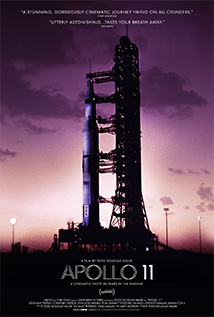 Apollo 11
Apollo 11
Director: Todd Douglas Miller
It does the heart well to be reminded occasionally of the potential of the human species. A comprehensive document of the 1969 Apollo 11 mission to the moon, from which came Neil Armstrong’s first steps on the lunar surface, Apollo 11 assembles 35mm, 16mm, and closed circuit footage, as well as over 11,000 hours of voice recordings and recently discovered 70mm rolls of everything from the spectators gathered at Cape Canaveral, to the three astronauts boarding the shuttle, to their post-spaceflight isolation having just splashed to Earth. The film presents all of this with marvelous resolution and clarity, the work, apparently, of some 400,000 people united as an act unprecedented preservation. Accordingly, it’s all pretty astounding; given so much context, such intimacy with the impossible, one can’t watch without clinging to disbelief as the only safe haven from truly understanding the immensity of what these three men are encountering, 239,000 miles away. Apollo 11 leans into that tension, stokes that fear as it mounts a thriller from its procedural elements. The approach is warranted: In the tide of history, we are terrified. It helps to remember, to try to get to know, people who have overcome this existential despair before. People who came together and did something that shouldn’t have worked. People who attempted to do things because they were hard. —Dom Sinacola
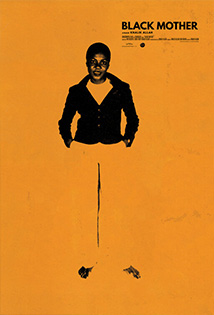 Black Mother
Black Mother
Director: Khalik Allah
When any advertising agency is commissioned to shoot a Jamaican tourism commercial, they’ll inevitably wend their way around to the same old hook: Bob Marley’s “One Love.” Come and visit Jamaica, the land of All Right! Everything’s all right, all the time here on the Jamrock! The ad people are just following the path most traveled (and perhaps even dictated by travel agencies and tourism boards), promoting Jamaica as a land of leisure and ease, where the sun shines, people smile, life is good, and no one wants for anything, especially spiritual assuaging. Advertising may sell audiences on a Jamaican ideal, but with his documentary, Black Mother, director Khalik Allah achieves a goal far greater: presenting audiences with the truth, however lovely or hideous it may be. Allah’s approach takes the form of a visual essay/tone poem. It’s a fractured piece of work, a story about Jamaica the way that Hale County This Morning, This Evening is a story of Alabama. Allah’s filmmaking functions as stream of consciousness. He eschews narrative documentarian traditions. This approach poses a challenge to the viewer—Black Mother is made in a language rarely spoken in cinema, be it multiplex or arthouse. Allah throws his audience into the ocean and forces them to tread water, soaking in the country’s textures and contradictions and trauma. Through his lens, Allah presents a nation decayed by oppression, whether political, social or even religious, and a people forced to do whatever they can to sustain themselves. That doesn’t mean Allah is committing poverty tourism. Instead, he’s a character in the film, made invisible by the tool of his trade. But he lets the people he meets tell their stories in their words, and anchors those words to truth through imagery. The effect of Black Mother’s technique—Allah shot on both 16mm and HD—is dizzying to the point of overwhelming, but the discipline required to engage with it is rewarded by a singular moviegoing experience. —Andy Crump / Full Review
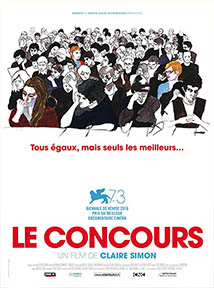 The Competition
The Competition
Director: Claire Simon
“Sit around and listen to French people argue about students of cinema for two hours” sounds like a drag, but Claire Simon’s The Competition doesn’t drag at all. It’s propulsive. Her film condenses the demanding application process at La Fémis, the most prestigious film school in all Paris, into just under 120 minutes, providing only the bare necessities for context and comprehension before launching into a series of tests and interviews, corralled as vignettes. That The Competition’s narrative is so cohesive belies the absence of cohesion in La Fémis’ examinations. The school’s hopefuls number in the hundreds, vying for just 40 slots; the observers in charge of their fates range from theater managers to filmmakers to critics and editors and everything else in between, and they, too, number on such a scale that objectivity becomes a joke.
Maybe that’s as it should be. Film, after all, and arts criticism writ large, is a subjective gig. Watching the observers’ various subjectivities collide turns out to be a hoot at times, a learning experience at others, or just good drama at others still. Surprise: Putting a bunch of French folks in one room and letting their passions and tempers flare makes for good filmgoing!
Simon’s fly-on-the-wall approach functions as an investment in the process, and in the outcome of the process for the select few students we get to meet. There are too many waiting their turn for Simon to chronicle all of them, but those that do make in front of her camera give context and rationality to their seemingly irrational bid for a spot at La Fémis: Cinema, to them, is everything, whatever side of the industry they’re interested in taking. It’s worth the stress of the process. It’s worth the great risk of failure. Simon hasn’t just captured La Fémis’ enrollment philosophy in The Competition, she’s captured its would-be students’ hopes and ambitions, and treated them with loving care. —Andy Crump
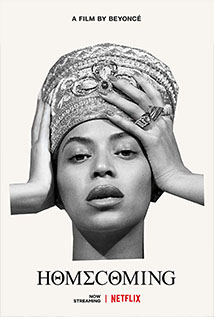 Homecoming
Homecoming
Directors: Beyoncé Knowles-Carter, Ed Burke
Childish Gambino, Ariana Grande, Tame Impala: None of those performers, or any of the others at Coachella 2019, were able to match the grandiosity of Beychella, Beyoncé’s epic pair of sets at last year’s festival. Netflix’s Homecoming, a documentary written, produced and directed by Mrs. Knowles-Carter herself, features stunning footage of each weekend’s set and dives deep into the symbolism, production and eight-month rehearsal process behind Beychella. The film also arrived with a surprise live album encompassing the entire Coachella set as well as new music. It’s all just The Carters’ latest in a long line of masterpieces, a colossal, visually stunning spectacle that not only summarized Beyoncé’s 20-year career, but also Historic Black Colleges in an entirely new way. We see clips from football games at schools like Howard University and Alabama A&M interspersed with Beychella rehearsal footage, the entire performance and film a celebration of those institutions, perhaps even an antithesis to what most people would consider a primarily white experience. If you haven’t seen it yet, you might want to consider canceling your plans tonight: Bey deserves your full attention. —Ellen Johnson
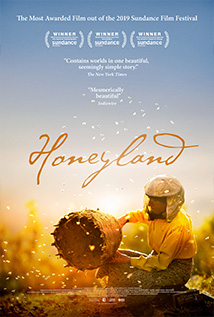 Honeyland
Honeyland
Directors: Tamara Kotevska, Ljubo Stefanov
With great warmth and reverence, Honeyland mourns a fading way of life—a way through which we’re introduced to Hatidzhe, whose whole life resonates, on some primordial level, with beekeeping. She climbs steep heights and navigates narrow ledges of rural Macedonia until she brings us to a honeybee colony she’s discovered deep in the face of a mountainside. She takes a few combs, carefully wraps them for the slow journey home. She lives without electricity in a village all but abandoned were it not for her bedridden mother, whose head’s half-wrapped with a scarf to hide a wound or large sore, it’s not clear, whose only company when Hatidzhe walks to town to sell jars of honey are the flies she attracts. Hatidzhe tends to her bees—only taking “half” the honey, leaving the rest for the burgeoning colony—in the ruins of what might have once been a thriving town, and her mother sleeps, occasionally rising to eat honey, or a banana, just a little. This is how their days pass, until a big family of neighbors rolls up with a camper, some cattle and a desperate ambition to make something out of all that land.
Though she may be too gregarious and giving for her own good, Hatidzhe welcomes the company, even if the family’s patriarch, Hussein, can be an abusive blowhard. Even if he gets a touch too curious about Hatidzhe’s talent with bees, squeezing her for secrets. Even when he starts his own beekeeping operation, but has nothing of Hatidzhe’s respect or patience or preternatural connection to the insects. Even when his hives ruin hers. Devoid of voiceover or chyrons describing location or anyone’s name—told only through a language most English-speakers admittedly wouldn’t recognize and a bed of sound on which rests a beautifully remote, mountainous ecosystem—Hatidzhe’s story quietly unfolds. There’s not much she can do as Hussein co-opts her calling, especially when Hussein’s investor insists he drive his hives into the ground to reap “enough” honey. One can easily catch metaphors about mass-market industrialization, or conjure up less material parables about humans’ insatiable urge to annihilate everything in their paths. Honeyland resists the tendency to sprawl out. Instead, Hatidzhe must accept what’s happened and move on. We do the same. —Dom Sinacola
 The Hottest August
The Hottest August
Director: Brett Story
The Hottest August has a novel structural hook: Director Brett Story spent every day of August 2017 interviewing people across New York City, getting to know them, observing them at their jobs, at their homes or during their downtime. And while she asked them lots of different questions, one common inquiry kept popping up: Do you worry about the future? What Story learns is that, for the most part, the answer is yes. Why people are worried—and how they’re learning to cope—is what powers this remarkable documentary.
With the help of wizard editor Nels Bangerter—who previously worked on Let the Fire Burn and Cameraperson, two documentaries absolutely dependent on editing to establish their rhythm and pacing—Story moves from subject to subject, only occasionally returning to an interviewee later in the film. We meet someone working in virtual reality. We meet someone who runs a facility where people can break stuff in order to relieve stress. We meet skateboarding teens. We meet a middle-aged married couple relaxing outside their home. We meet flood victims. We go to baseball games and bars and parties, and we hang out with folks who are checking out that month’s total solar eclipse. And if you remember a cataclysmic moment that happened in America that month, well, you’ll see that integrated into The Hottest August as well—integrated so offhandedly and elegantly that the moment shocks and stings all over again.
What precisely is Story driving at? The Hottest August’s beautiful mosaic invites a personal, intimate interpretation—the movie is about a dozen things if it’s about any one thing. There’s an apocalyptic tenor to the film, which touches on global warming and the seemingly systemic belief (especially among her younger subjects) that the future will be bleak—if there’s even a future at all. And yet, the movie finds such warmth in its depiction of these sometimes kooky individuals. Story doesn’t judge her interviewees, and the cacophony of different voices, if anything, speaks to what’s still so extraordinary about human beings, despite their endless limitations and idiocies. —Tim Grierson
 Jawline
Jawline
Director: Liza Mandelup
Social media influencer manager Michael Weist flippantly remarks to the camera, “Influencers come and go, the business stays the same.” He says it dispassionately—the same way he treats his clients. He understands that this is fundamentally work, a form of labor, a kind of risky, fleeting employment; the influencers he manages represent a fruitful, but ultimately short-lived, gold rush. The only person who knows that better than him is Jawline director Liza Mandelup, but she extends to these subjects—particularly to the primary one, live streamer and aspirational influencer Austyn Tester—empathy and kindness. Perhaps it’s because she can grasp so well that the social influencer economy is an extreme, fraught business that her kindness and fairness reveals itself through her filmmaking. If social media influencing is a new kind of American Dream, maybe even more illusory than whatever that idea represented before, she takes no joy in watching the struggle of someone like Tester, from lower socioeconomic means, try to reach for a transient status that considers him disposable. And though Tester might not himself understand his appeal to fans, Mandelup, again, does: He’s naive and young enough so that his positivity and his idea of authenticity are free of jaded calculation and conscious performance. He is, apparently, as he presents himself, and whatever is omitted from his streams or posts is an extension of that innate charm and ambition. Mandelup crafts a film of impressive insight into the way our identities, consciously conceived or otherwise, maintained online have become a lot of work, and how some people are willing to make that a vocation, no matter the cost. —Kyle Turner
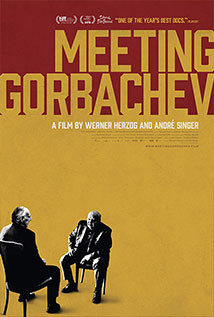 Meeting Gorbachev
Meeting Gorbachev
Director: Werner Herzog
Werner Herzog is a documentarian who has always been interested in the multitudes of the human experience. Dour, poetic and blunt—Herzog’s films are like Herzog, as much about outward expeditions into the unknown as they are obsessively introspective looks into the filmmaker himself. But in Meeting Gorbachev, Herzog trades his self-seriousness for fandom, or at the very least, what fandom looks like when filtered through the meta-textual lens that is Werner Herzog the man, the story-hyperbolizing myth, the meme. Herzog sits down with an ailing Mikhail Gorbachev to swap words about the objective truths regarding the histories that the two men have experienced, lessons they’ve learned and how one—anyone—never really stops suffering. It may sound very Herzogian, but the conversational and subjective reality that flows jazz-like through their various dialogues cannot be overstated. Their exchanges are less Socrates versus Glaucon and more akin to two old weary souls sharing a pint at a sticky-floored pub as the modern world continues to ebb and flow all around them. Meeting Gorbachev is a triumphant look at history through the most subjective of lenses—the spoken word. —Cole Henry
 Midnight Traveler
Midnight Traveler
Director: Hassan Fazili
Afghan filmmaker Hassan Fazili gives viewers a harrowing immigrant experience in the form of Midnight Traveler, which chronicles his family’s frightened exodus in the wake of the Taliban calling for his death. (Fazili had made a documentary, Peace in Afghanistan, about a former Taliban fighter, Mullah Tur Jan, who renounced his ways. After that film’s airing, the Taliban killed Tur Jan.) Shot on three mobile phones, Midnight Traveler was chiefly a way for Fazili, his wife (filmmaker Fatima Hussaini) and their two young daughters to document their three-year ordeal, traveling through deserts and snow in the hopes of reaching sanctuary in Europe. But as Midnight Traveler rolls along, it becomes clear that Fazili wasn’t just trying to make an official record of their torment—he was trying to instill normalcy in a situation in which normalcy was nearly impossible.
As a result, the notion of documentaries as home movies is especially fascinating in regards to Midnight Traveler. Like Revereza, Fazili might not have been explicitly thinking about making a film, but the finished product (co-directed by Emelie Mahdavian, who’s also credited as the movie’s editor and writer) is alternately gripping and disarming. A buzzing sound design hints at the unease that Fazili’s family feels at all times, but then there are these seemingly ordinary domestic scenes—brief glimpses into family life in which we see parents and children spending time together, even if it’s in a makeshift refugee camp.
Even then, though, the images are fraught. During a key moment in Midnight Traveler, one of Fazili’s daughters enthusiastically dances to Michael Jackson, mimicking his moves. For a moment, viewers’ conflicted feelings about the King of Pop, whose legacy of alleged child sexual abuse was laid bare in Leaving Neverland, melts away in that girl’s happy playing. And yet, her difficult situation—an Afghan without a home—is punctuated by her impassioned singing along to Jackson’s “They Don’t Care about Us,” an attack on racism and bigotry that speaks to this young woman’s reality more profoundly than anyone should have to endure. —Tim Grierson
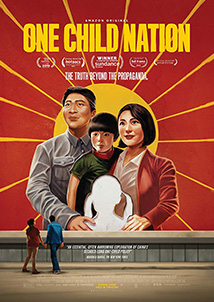 One Child Nation
One Child Nation
Directors: Nanfu Wang, Lynn Zhang
The idea of the perfect family unit, its presence on television or in advertisements or in books, is a kind of propaganda. Everyone knows this, knows that idea embeds itself into political and cultural consciousnesses, knows that propaganda becomes an integral part of the identity, of the very notion of “family.” In Nanfu Wang and Lynn Zhang’s blistering One Child Nation, Wang digs deep into her past, comprised of the artifacts of propaganda that allowed the “One-Child Policy” in China to flourish. The film strikes a balance between investigative journalism and memoir, interrogating both the cultural texts that propagated the policy’s importance—its “benefits”—as well as the people in her life who were complicit in its consequences. It’s a documentary that cuts close to the bone, its rawness never undermining its commitment to challenging the institutions that allowed such a destructive policy to operate. As Wang questions her own connection to family and policy, the film unearths how politics can so easily shape family life itself. —Kyle Turner
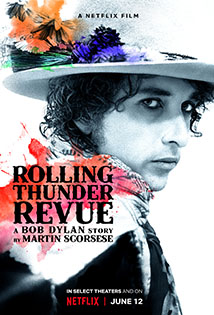 Rolling Thunder Revue: A Bob Dylan Story by Martin Scorsese
Rolling Thunder Revue: A Bob Dylan Story by Martin Scorsese
Director: Martin Scorsese
Bob Dylan’s life and career are so encased in myth that it can be hard to untangle the romanticism from the reality. As much a symbol as he is a man, Dylan has spent most of his adulthood resisting being labeled the voice of his generation while slyly welcoming fans’ desire to dissect his every utterance, devoting much of the last couple decades opening up the vaults to release a series of official “bootleg” recordings associated with his most iconic albums and tours. He invites us to look deeper and listen harder, as if the answers can be gleaned from closer study. Long before David Bowie, Tom Waits, Madonna or Lady Gaga dabbled in persona play, Robert Zimmerman made us ponder masks in popular music. He’s both there and not there, which can be frustrating and fascinating. Both sensations are on display in Rolling Thunder Revue, the oft-spectacular, sometimes shtick-y chronicle of Dylan’s 1975 Rolling Thunder tour. As is typical when depicting anything in the Dylan universe, this concert film/documentary simultaneously oversells its subject’s genius and provides overwhelming evidence of what a brilliant artist he is. The documentary’s full title should also be a disclaimer: Rolling Thunder Revue: A Bob Dylan Story by Martin Scorsese. Early on, the movie features a contemporary interview from Dylan confessing that he doesn’t quite remember what prompted Rolling Thunder or what his ambitions were. “I don’t have a clue because it’s about nothing,” he says, another example of obscuration and seduction. The movie is a “story,” which means some parts might be invented or exaggerated, and because it’s “by Martin Scorsese,” the whole film is filtered through one artist’s perspective on another. Scorsese is after something grander than mere documentation—more layers of myth are applied while trying to present an honest account of a tour and a performer. At nearly two-and-a-half hours, Rolling Thunder Revue is overlong but also overpowering, inconclusive yet undeniably stirring. It left me exhausted, but I kinda want to see it again. —Tim Grierson / Full Review
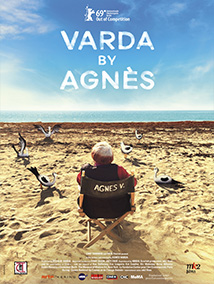 Varda by Agnès
Varda by Agnès
Director: Agnès Varda
“Nothing is trite if you film people with empathy and love.” There’s no better summary of Agnès Varda as a filmmaker, as a visual artist, as a humanitarian, and simply as a human. Think of Varda by Agnès as its namesake’s Blackstar: A parting salvo cast upon the world, her way of saying “bon voyage,” giving the final word on her life and times to no one but herself. Few people get to choose the terms on which they leave this world. Varda being Varda, she negotiated her own terms in a deal that makes Death look like a chump. This is her valediction, immutable, and without a pause given for objections or corroboration, except when she allows. And so, Varda by Agnès functions on a familiarity spectrum: If you know her work back to front, then the film feels like a chance to stroll through her oeuvre, Agnès at your side as your personal guide. If you know nothing of Varda’s work save for the names of her movies, then this is a terrific introduction, not only to the movies themselves but to Agnès: Her spirit, her aesthetic, her philosophy. It’s Varda 101, taught only as Varda can. Film is for everyone. Film is by everyone. Varda was, and in memory still is, one of the great champions of film as a communal experience. Varda by Agnès lets the artist tie up loose threads on her life, and lets audiences bask in the warmth of her egalitarianism. —Andy Crump
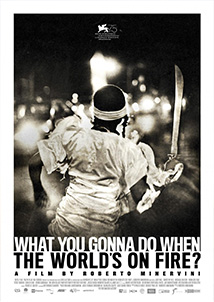 What You Gonna Do When the World’s on Fire?
What You Gonna Do When the World’s on Fire?
Director: Roberto Minervini
Roberto Minervini’s hybridized films skirt the fringes of documentary and drama as oneirically as they float on the sidelines of civilization. An Italian filmmaker who concentrates almost wholly on the American South, Minervini is a preternatural outsider, observing the daily goings on of a nonprofessional cast, often populated by those who would otherwise never find the chance to have their stories, however ostensibly ordinary, told. His films, like those of Frederick Wiseman or more recently celebrated impressionistic documenters, Khalik Allah and RaMell Ross, gracefully examines whatever “ordinary” is supposed to mean. He’s an outsider revealing the lives of outsiders, bound to his subjects by their shared liminality more than most Americans would ever be. So it makes sense that he never feels obliged to stick to straight objectivity, but never has much of a desire to fictionalize the events of those he follows either. He nudges his subjects into a cinematic frame without contrivance. The starkly political messages of his films flow consequently from the intimacy of the images he captures, grasping the deeply personal and overtly public as one in the same.
In his 2015 film, The Other Side, Minervini explored the margins of the deep South—meth addicts, militia members and racism abound, as do Hillary Clinton supporters, which in retrospect feels near-whimsical—at the end of the Obama presidency, finding, without judgment, horror and violence paired irrevocably with tenderness and peace. His latest feature, What You Gonna Do When the World’s on Fire?, predictably sticks to the same region, this time to New Orleans, though with less noticeable framing devices and even less context. Minervini expects viewers to understand the cause and effect coursing through the three African-American stories he weaves together, to have a notion of why 50-year-old Judy Hill is losing her bar, her life’s dream, to a tide of gentrification; why brothers King (14) and Titus (9) navigate a world of subcutaneous fear; why Krystal Muhammed is so unrelenting in her activities chairing the New Black Panther Party for Self Defense, why they’re so righteously angry. Minervini isn’t compelled to lay bare the lifetime of sexual and drug abuse that haunts Judy and so many of her peers, or carve out a procedural around the police’s killing of Alton Brown, or dissect the gang violence that has King and Titus’s mom begging them to be home before the streetlights come on. Instead, inside of cinematographer Diego Romero Suarez-Llanos’s handsome, stentorian black-and-white, Minervini refuses to dredge drama from these lives, preferring notions of the everyday that represent more empathetic truths: how the film begins with King gently soothing the frightened Titus as they move through a fun house, or how Judy’s seemingly ancient, ailing mother bears no memory of her daughter’s trauma in passive conversation, or how the Mardi Gras Indians, in a city forever recovering from Hurricane Katrina, still practice, still put on a show, still summon the strength to give their community a celebration. This is the “ordinary” for Minervini’s subjects; its power, Minervini knows, needs no background. —Dom Sinacola